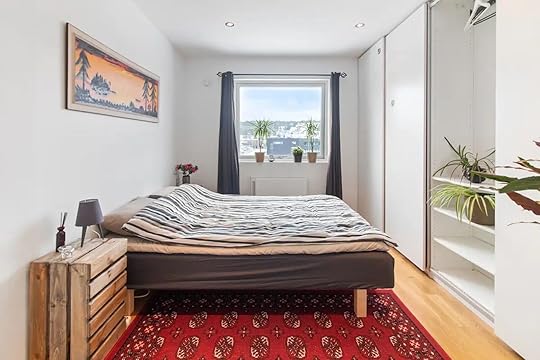Matador Network's Blog, page 279
July 6, 2023
9 Oslo Airbnbs That Capture Norwayâs Charm and Cozy-Chic Aesthetic

Norwayâs enchanting capital, Oslo never fails to capture the hearts of visitors. Itâs a place where the charms of the past blend seamlessly with the thrills of modern life, where the natural beauty of fjords and mountains contrast with a bustling city life, and where visitors can enjoy cultural attractions ranging from museums and galleries to exciting shopping and dining destinations. Osloâs far from the biggest city in Europe, but your experience of the city can vary wildly depending on where you stay. From lively areas like Frogner and Aker Brygge to quieter neighborhoods thatâll make you feel like a local, these are the Oslo Airbnbs to book.
We hope you love these Oslo Airbnbs! Just so you know, Matador may collect a small commission from the links on this page if you decide to book a stay. Listed prices are accurate as of the time of publication.
Penthouse with a Rooftop Terrace Photo:
Photo:  Photo:
Photo:  Photo:
Photo:  Photo:
Photo:  Photo:
Photo:  Photo:
Photo: Spanning nearly 1,300 square feet, this sandwiched between parks is quite spacious for a one bedroom, especially when you factor in the 320-foot rooftop terrace â a perk of booking a penthouse Airbnb in Oslo. It has all the amenities youâll need for a comfortable and functional stay â including fast WiFi, two living room spaces, an indoor fireplace, a fully equipped kitchen with plenty of counter space, and a dining room table that seats seven â but youâll also love the look of the apartment. In true Scandi fashion, the artsy interior is both cool and homey.
One bedroom, two guests
Price per night: $129
 Photo:
Photo:  Photo:
Photo:  Photo:
Photo:  Photo: Airbnb
Photo: Airbnb Photo:
Photo:  Photo:
Photo: This luxurious is located in Osloâs Aker Brygge wharf area, meaning guests have access to tons of popular restaurants, bars, cafes, shops, and markets, as well as beautiful views of the inner harbor. The apartment is perched on the ninth floor of its building with a spacious balcony, but you can also take in panoramas of the water, Oslo fjord, and Akershus Fortress from the buildingâs shared rooftop terrace. Best of all, guests have access to a swimming pool thatâs heated to 82 degrees Fahrenheit throughout the year.
Two bedrooms, four guests
Price per night: $262
 Photo:
Photo:  Photo:
Photo:  Photo:
Photo:  Photo:
Photo:  Photo:
Photo: A quick walk from Osloâs central station, this is the perfect base to take in the city, from strolling along the Akerselva river, to touring the botanical garden a five-minute walk away, to shopping at the Oslo City or Byporten mall, to soaking up the sights along the Karl Johans Gate, the main street that runs through the city. Back at the Airbnb, youâll find a comfortable bedroom thatâs perfect for a couple, a recently renovated bathroom with a washer and dryer if you need one, and modern electronics with a variety of streaming services to enjoy during your downtime. On sunny days, youâll love having a balcony complete with a gas grill.
One bedroom, two guests
Price per night: $164
 Photo:
Photo:  Photo:
Photo:  Photo:
Photo:  Photo:
Photo:  Photo:
Photo:  Photo:
Photo: Located in Osloâs Løren neighborhood, not far from the airport, this can comfortably house up to four guests, making it a great choice for families or groups of friends. The master bedroom has a queen bed while the second bedroom has a double bed. The rest of the apartment is great for shared living, from the open kitchen and large dining room to the living room with a gas fireplace and the private balcony outside. Itâs not the liveliest area of Oslo, but itâs perfect for travelers who want to be in a quiet area with access to grocery stores, cafes, and plenty of public transportation for when they want to access the busier parts of the city.
Two bedrooms, four guests
Price per night: $131
 Photo:
Photo:  Photo:
Photo:  Photo:
Photo:  Photo:
Photo:  Photo:
Photo: High ceilings, large windows, striking navy blue accent walls, and immaculate decor welcome you to this once you enter the classic building that houses it. Staring out the windows wonât yield city views, but you will get to admire an enclosed courtyard that lends the apartment a peaceful quality. The apartment is located in Osloâs Torshov neighborhood, which plays host to two parks and a main street, Vogts Gate, where youâll find plenty of cafes and restaurants to keep you energized while you explore the area and beyond.
One bedroom, three guests
Price per night: $68
 Photo:
Photo:  Photo:
Photo:  Photo:
Photo:  Photo:
Photo: If you like high-end shopping, swanky dining, and otherwise going all out on vacation, this elegant in the Frogner borough is an excellent choice. Itâs located in the central and highly coveted Vika neighborhood, adjacent to Aker Brygge, near another lively neighborhood called Tjuvholmen where youâll find attractions such as a sea bath, beach, lawn, sculpture park, and exciting art galleries. The apartment is also within walking distance of shopping streets in the city center such as Bogstadveien and Karl Johans Gate, tons of excellent dining, and popular parks such as Slottsparken, Hydroparken, and Kontraskjæret.
One bedroom, three guests
Price per night: $155
 Photo:
Photo:  Photo:
Photo:  Photo:
Photo:  Photo:
Photo:  Photo:
Photo:  Photo:
Photo: Road-trippers or family vacationers, this is the Oslo Airbnb for you. The is conveniently located near a metro station that can take you to the city center in a matter of minutes, but it also comes with free street parking. Youâll be on the top floor of the building, but you should note that thereâs no elevator, so you should be prepared to carry your luggage up to the fourth floor. When you get inside, youâll find a master bedroom with a queen bed, a second bedroom with a double bed, and a couch that can be used as an additional bed, plus a few fun features including heated floor tiles in the bathroom and a cozy enclosed balcony.
Two bedrooms, five guests
Price per night: $88
 Photo: Airbnb
Photo: Airbnb Photo:
Photo:  Photo:
Photo:  Photo:
Photo: This has the best of both worlds â or both sides of Oslo, at least â being located on a serene street thatâs a mere five-minute walk from the most energetic spots in the city. Anywhere you canât reach on foot you can access via the Skillebekk tram station, which is only two minutes away on foot, is a one-minute ride from the city center, and connects to every station in Oslo. After a full day of sightseeing, youâll appreciate having an immaculate home base to retreat to, complete with a grassy courtyard where you can soak up the rays.
One bedroom, four guests
Price per night: $124
 Photo:
Photo:  Photo:
Photo:  Photo:
Photo:  Photo:
Photo:  Photo:
Photo:  Photo:
Photo: Top-notch amenities, tons of natural light, and a private balcony overlooking a verdant backyard are a few of the perks of this near Bogstadveien, Oslo’s main shopping street, and Vigeland Sculpture Park, a popular tourist attraction in Norway. The apartment is situated on the fourth floor with elevator access. It comprises two bedrooms and two bathrooms, both of which have showers and heated floors. The modern kitchen is fully equipped and connected to a dining area that features a large dining table, and the spacious living room has a generous seating area and a large TV with Netflix . 
Two bedrooms, four guests
Price per night: $208
These Airbnbs Let You Sleep Close To the Taj Mahal

The Taj Mahal is not only an iconic landmark but a timeless symbol of beauty and romance. Not only does it have an incredible history behind it, but the intricate detailing and architecture make it a sight to behold in person. With its sprawling white marble walls and grandiose domes, visitors can experience the true majesty of this UNESCO world heritage site. The colorful gardens, fountains, and reflection pools add to the tranquil ambiance of this destination, making it a great place to relax and take in some incredible views. These are some of the closest Airbnbs to the Taj Mahal.
Traveling to India? Check out Matadorâs India accommodations guides: The most luxurious hotels on the coastline of Goa, India Goa, India Offers the Country’s Coolest Airbnbs. These 11 Are Proof. 7 luxury hotels in Jaipur with the finest hospitality in Rajasthan Experience the best of Mumbai from these cozy Airbnbs These Jaipur Airbnbs put you in the heart of a beautiful city The Best Hotels Near the Taj Mahal With Incredible Views and Service These New Delhi Airbnbs Help You Find Your Footing in a Massive City
We hope you love these Airbnbs near the Taj Mahal! Just so you know, Matador may collect a small commission from the links on this page if you decide to book a stay. Listed prices are accurate as of the time of publication.
Spacious, quiet condo with multiple balconies and a scenic view Photo: Airbnb
Photo: Airbnb Photo: Airbnb
Photo: Airbnb Photo: Airbnb
Photo: Airbnb Photo: Airbnb
Photo: AirbnbSee more photosOutside the Taj Mahal, this spacious and quiet property sits in a gated community on the outskirts of town and features two balconies and an outdoor space with a scenic view. Inside, the rooms have air conditioning and a clean black-and-white design. The living room features a sofa and a TV, and a dining table for sharing a meal. The fully equipped kitchen has a microwave, a toaster, and a fridge, and thereâs complimentary breakfast included in the stay.
Five guests, two bedrooms
Price: $60 per night
 Photo: Airbnb
Photo: Airbnb Photo: Airbnb
Photo: Airbnb Photo: Airbnb
Photo: Airbnb Photo: Airbnb
Photo: AirbnbSee more photosThis spacious, clean, and cozy air-conditioned home is the perfect Airbnb near the Taj Mahal and close to numerous restaurants and clubs. The decor is warm and inviting, with two king beds and two thick floor mattresses for sleeping. Additional amenities include filtered drinking water and a smart TV for relaxing and settling in front of a show.
Six guests, two bedrooms
Price: $34 per night
 Photo: Airbnb
Photo: Airbnb Photo: Airbnb
Photo: Airbnb Photo: Airbnb
Photo: Airbnb Photo: Airbnb
Photo: AirbnbSee more photosThis clean and colorful property in Agra, Taj City, is a calm spot to be a home base to explore the region. The first floor hosts three bedrooms which feature air conditioning, and thereâs a kitchen area and a dedicated dining room space. Spend time out on the balcony, and enjoy the fresh air. The hosts live on the first floor and are happy to organize experiences for each guest.
Twelve guests, three bedrooms
Price: $67 per night
 Photo: Airbnb
Photo: Airbnb Photo: Airbnb
Photo: Airbnb Photo: Airbnb
Photo: Airbnb Photo: Airbnb
Photo: AirbnbSee more photosThis pet-friendly large property hosts a combined study area and living room, a full kitchen with a coffee machine and toaster oven, a big bedroom, a clean bathroom, and an outdoor terrace with patio furniture. The space has AC, and an in-unit washer is a quiet spot to settle in before exploring the area.
Four guests, one bedroom
Price: $47 per night
 Photo: Airbnb
Photo: Airbnb Photo: Airbnb
Photo: Airbnb Photo: Airbnb
Photo: Airbnb Photo: Airbnb
Photo: AirbnbSee more photosThis home-away-from-home is a peaceful, private and welcoming space close to the Taj Mahal. Itâs fully furnished and air-conditioned and sits in a prime location for exploring. Each of the three bedrooms features a king bed, and there are two additional single beds. There is a back patio for spending time outside and a large living room space inside with a comfy sofa and a TV. The Kitchen is outfitted with a gas stove and cookware and a glass dining table that seats six people.
Eight guests, three bedrooms
Price: $34 per night
 Photo: Airbnb
Photo: Airbnb Photo: Airbnb
Photo: Airbnb Photo: Airbnb
Photo: Airbnb Photo: Airbnb
Photo: AirbnbSee more photosThis colorful and clean, pet-friendly guesthouse is the definition of âcommunity.â Itâs near the Taj Mahal and features a rooftop made for yoga sessions and relaxation, as well as a kitchen, a dedicated workspace, and multiple bedrooms. Two bedrooms feature a king bed and a sofa bed, two bedrooms feature a single king bed and a third type of bedroom with one single bed and five bunk beds.
Sixteen-plus guests, six bedrooms
Price: $145 per night
 Photo: Airbnb
Photo: Airbnb Photo: Airbnb
Photo: Airbnb Photo: Airbnb
Photo: Airbnb Photo: Airbnb
Photo: AirbnbSee more photosThis colorful and large three-bedroom, three-bathroom penthouse has a full kitchen for cooking and air conditioning to keep cool in the summer. There are two balconies, a large living room, and a newly renovated roof deck with views of the Taj Mahal. Within the apartment complex, there are two small parks, a temple and a restaurant that serves tasty cuisine.
Seven guests, three bedrooms
Price: $60 per night
 Photo: Airbnb
Photo: Airbnb Photo: Airbnb
Photo: Airbnb Photo: Airbnb
Photo: Airbnb Photo: Airbnb
Photo: AirbnbSee more photosThis tranquil home is close to the temples. A 24/7 security guard protects it, and there are two gardens, a gym, and a home theater in the propertyâs complex. Spend time on the balcony, or walk around the gardens for fresh air.
Four guests, one bedroom
Price: $13 per night
According to Housing.com, itâs said that the Taj Mahal may have cost nearly Rs 70 billion â or around $1 billion in todayâs dollars.
Can you go inside the Taj Mahal?Yes! You can go inside the Taj Mahal. According to Timesofindia.com, the Taj Mahal is open to visitors from 6 a.m. to 7 p.m. every day, except on Fridays (when it is closed for prayers).
How many rooms are in the Taj Mahal?The Taj Mahal has more than 100 rooms, some of which are still âsealed.â
Is there a dress code for the Taj Mahal?According to Whattopack.com, there isn’t a set, enforced dress code required to go inside the Taj Mahal, but just like anywhere else in India, visitors will still want to be cautious and respectful â which means covering up their shoulders and knees. 
In AlUla, Luxury and History Blend With Unmatched Outdoor Adventure

Visually, parts of AlUla feel like the set design for Star Wars: A New Hope thanks to an expanse of beige-colored desert mountain ranges in each direction. On a recent visit, myself and a group of travelers joked that we half-expected Jawas and Jedis to appear from behind a 12-story chunk of aeon-old sandstone rock.
AlUla, of course, has more to it than just loads of breathtakingly diverse landscapes.
Located 1,100 km from Riyadh, in northwest Saudi Arabia, AlUla is a sweet spot where natural and modern wonders beg to be traversed. Its ancient heritage sites date back many millennia, with hieroglyphs etched in stone and tribal tombs. Its twenty-first century culture includes a revitalized upscale market, a lush oasis valley, and heart-pumping activity, among others.
Thankfully, youâre not going to be bumping elbows with the tourist throngs â at least not yet. While previously a stopover for Saudis en route to the Hajj in Mecca, AlUlaâs primed to receive more attention now that the Kingdom has opened up in recent years as it embraces sweeping cultural reforms.
Visas to the country are good for 90 days, but you can fit a lot a week here.
An adventure itinerary to AlUlaAlUla Skies FestivalView this post on InstagramA post shared by AlUla Moments ÙØظات اÙعÙا (@alulamoments)
From the last week in April to mid-May, enjoy watching hundreds of hot air balloons take flight. You can also get in a basket to enjoy and appreciate AlUlaâs majestic landscape, the desert expanse, from a mile in the sky. Morning takeoffs offer an elevated view of Hegra, while afternoon flights give a 360-degree view of the region.
AlUla Skies Festival: Winter park, Hegra 43542, Saudi Arabia
The Adventure HubView this post on InstagramA post shared by AlUla Moments ÙØظات اÙعÙا (@alulamoments)
This is adrenaline-central for trips to AlUla. Steady those steps on the 45-meter-long ladder up the side of a cliff (with safety harness). At the top, take a heart-stomping 150-meter zipline into the canyon below. Afterward, prepare for the equivalent of a right-side up bungee jump, called The Giant Swing, dropping 85-meters while suspended by cables.
The Adventure Hub: MVG8+7M5, AlUla 43513, Saudi Arabia
Walk the Nabataean city of Hegra
Photo: Dave Gordon
The Nabataean city of Hegra is a UNESCO World Heritage Site where you can explore any number of a hundred tombs carved in stone. The jaw-droppingly intricate facades will invariably elicit comparisons to Petra, Jordan. The big difference is that your photos will not include scads of other photo-bombers like in Petra. Hegra was the main southern city of the Nabataean Kingdom, and the southernmost outpost of the Roman Empire, after conquering the Nabataeans in 106 CE.
Hegra tourist entrance point: QW5W+6V9, Hegra 43541, Saudi Arabia
Dadan and Jabal Ikmah tour
Photo: Dave Gordon
Transport yourself into the ancient city of Dadan to view 2,000-year-old storytelling in ancient languages as you peer in the hieroglyphic rock inscriptions from the Lihyanite and Dadanite civilizations. Departing from Winter Park, a shuttle bus takes you to Dadan and then a short drive away to the desert canyon where Jabal Ikmah sits. The latter is where youâll see rock art and petroglyphs carved into the desert rocks. International archaeology teams continue to find new and exciting finds, so you may arrive at a time when a discovery has been made during the two-hour tour.
Dadan and Jabal Ikmah tour departure point: Al Ula 43532, Saudi Arabia
Oasis Heritage Trail
Photo: Dave Gordon
A 1.8-miles trail snaking through the shaded palm groves, streams, and gardens affords you the chance to see up close how local farmers grow abundant crops. Open all day and night, this free trail is perfect for a quiet stroll or an Instagram shot of basking in greenery. You can also hire a guide to lead you, and give descriptions of what you see en route.
Oasis Heritage Trail: JWG8+RM4, AlUla 43523, Saudi Arabia
Elephant Rock (Jabal AlFil)
Photo: Dave Gordon
One of the regionâs most famous formations, this towering natural arch in the middle of the desert stretches 170 feet into the sky. It has a cool factor that you can take in from any one of a number of stylish seats sunken in the ground, and at night (the location is open from 4:00 PM to midnight), bonfires keep away the desert chill under a backdrop of stars.
Elephant Rock: MXQJ+F2, AlMu’tadil 43539, Saudi Arabia
Old Town Village
Photo: Dave Gordon
Touted as âone of Northwest Arabia’s most impressive heritage sites,â this honeycomb of 700-year-old mud-brick homes was a once-thriving settlement along ancient trading routes. The Villageâs street market sells everything from tchotchkes to soaps, teas, locally-made food items, abayas â you name it. Moringa, a plant that grows abundantly in the region, is known for its medicinal properties, and is sold in various kinds of items, such as tea, soap, and essential oils. Nearby AlJadidah Arts District, meanwhile, is a cultural hub with stunning murals, art expos, curio shops and eateries.
Old Town Village: JWG7+6X4, AlUla 43541, Saudi Arabia
Maraya
Photo: Dave Gordon
This exhibition and concert venue is also the worldâs largest mirrored building, reflecting the mountains and canyons. Itâs known for hosting A-list performances like John Legend, Andrea Bocelli, Maria Carey, Russell Peters, Alicia Keys, and more. When I visited, FAME: Andy Warhol Exhibition was on display, showcasing some of the legendary artistâs most iconic works, including paintings of Marilyn Monroe and Jackie Kennedy.
Maraya: Al Atheeb 43552, Saudi Arabia
Where to stay in AlUlaWhen it comes to accommodations, itâs hard to beat the luxury and appeal of Banyan Tree AlUla or Habitas AlUla.
Banyan Tree AlUla
Photo: Dave Gordon
Launched in October 2022, this all-villa luxury tented resort is set against the backdrop of striking natural scenery and has all of the amenities you could ask for: kitchen, dining room, living room, patio, and, in some cases, a pool. Extra touches include spa treatments, an elevated outdoor pool built in a rock cavern, and its house restaurant, Harrat, with a vast full-spread breakfast buffet and a wide array of meal options.
Banyan Tree AlUla: Wadi Ashar, Tabuk Road, AlUla 43563, Saudi Arabia
Habitas AlUla
Photo: Dave Gordon
Billed as a âsustainable, experience-led resortâ with 96 rooms, a wellness center, and restaurant and bar that overlooks a multi-lane infinity swimming pool. Shuttle yourself from activity to activity on a buggy or scooter across campus, as each self-contained room is built at a distance from each other, guaranteeing privacy. You can also stay in a fully-equipped Airstream if youâre budget-conscious.
Habitas AlUla: Ashar Valley, AlUla 43511, Saudi Arabia
Where to eat in AlUlaSomewhere RestaurantThis Mediterranean-style restaurant offers both indoor and outdoor seating; with the latter, enjoy the backdrop of date palms. Moderately priced, dishes on the menu range from about $12 to $25, with options like hummus and Fatteh bars, traditional Middle Eastern flavors served in bao buns, and heartier fare as well.
Somewhere: JWH7+RH, 2600 Ù Ùس٠ب٠اÙÙصÙر, 7181, AlUla 43523, Saudi Arabia
SaffronThe only authentic Thai restaurant in the region, Saffron offers guests contemporary Thai dishes prepared by Thai chefs. Located in the Banyan Tree hotel, this is an elevated experience that comes with a bigger price tag. Dress is smart casual at Saffron, and itâs recommended to make a reservation. You can enjoy a set menu or sample as you wish from the vegetarian options, curries, shrimp, and steaks.
Saffron: Wadi Ashar, AlUla 43563, Saudi Arabia
OktoIf you are in the mood for Greek food and want a gobsmacking view, you canât do better than Okto, which sits atop Harrat Viewpoint overlooking the Old Town. Case in point: the restaurant even provides patrons with telescopes. From there you can enjoy souvlaki, salads, and an array of appetizers as you take in the AlUla Oasis and the desert. For an even more beautiful experience, make a reservation after sunset to enjoy your meal under the stars.
Okto: King Abdulaziz Park, AlUla 43562, Saudi Arabia
CircoloA casual Italian restaurant located near AlUla Oasis, Circolo offers an opportunity to eat some of the finest pizza in the region with gorgeous mountains in the foreground. You can watch your pizza bake while sitting on the neat, trendy patio. While pizzas are the specialty, the restaurant also serves handmade pastas and an assortment of salads made with local ingredients.
Circolo: JWJ7+FC6, AlUla 43523, Saudi Arabia
Tawlet FayzaThis cozy restaurantâs name translates to âFayza’s Table.â Appropriate, given the cozy family atmosphere. If youâre looking for an organic Arabic dining experience, this is it. Focused on fresh, local products, the menu changes regularly but every dish is inspired by the Arabic tradition of communal eating and family. All ages welcome and no reservations necessary.
Tawlet Fayza: DADA7409, 2503 اب٠بÙر اÙصدÙÙ, 7409, AlUla 43523, Saudi Arabia
Getting to, and around, AlUla
Photo: Dave Gordon
Flights from Dubai on Fly Dubai airlines reach the region, or you can fly from Riyadh on Saudi Arabian airlines or Flynas.
Once there, AlUla, at about 925 square miles, is quite large, and generally walkable only within each sightseeing stop. I highly recommend renting a car from one of the several car rental companies available at the airport. Car rental rates usually depend on the type of vehicle, but are comparable to most city rates in the US.
The best easier hikes in Nepal

Usually, when you hear about travelers headed to Nepal, they’re highly skilled athletes aiming to climb Mount Everest. That’s no wonder, given that Nepal is home to Mount Everest (the highest point on Earth), plus seven more of the highest mountains in the world. But Nepal had roughly 600,000 visitors in 2022, and only 425 climbers summited Everest. So it’s clear the vast majority of visitors to Nepal aren’t headed to bag the world’s highest peak.
So where are all those visitors heading? Easy answer: to one of the many other gorgeous mountains, national parks, villages, and regions of the roughly 57,00-square-mile country. As many visitors have discovered, there are amazing Nepal hiking trails that require zero training and are just as breathtaking, literally and figuratively, as Everest.

Photo: Brester Irina/Shutterstock
âWe like to say âMountain is about attitude, not altitude,ââ says Bimal Karki from Apex Himalaya, one of the top-rated Nepal hiking companies based in Kathmandu. His brother Bikram and their team of certified mountain guides led trips to fit a wide range of ages and abilities. âWe have experience hiking in the mountains with kids as young as three years, on up to 68 years old, from healthy people to people who suffer from asthma. Nepal offers different grades of adventurous activities from beginner hikers to hardcore mountaineers, and from backpacker to lavish traveler.â
If epic mountain vistas, fresh dumplings, spiced tea, and vibrant culture sound up your alley, but months of intense physical training does not, consider one of these five alternate Nepal hiking routes that any moderately fit person can totally handle.
Remember that hiking ratings are relative, and Nepal hiking comes with the added challenge of extremely high elevation. “Easy” for Nepal may still feel hard if you’re used to hiking in US state parks at sea level. Fortunately, using a guiding company is extremely common, and whether you book online in advance or find a guide when you arrive in the country, you’ll be able to ask questions before you begin. Guides can often alter routes in case of poor weather, arrange transportation to cut off more difficult sections, and find different types of lodging if shared teahouses aren’t your thing. If you’re very worried about your ability, book a private tour and discuss alternate and back-up hiking options with your guide in case your legs get too sore on day three to make it to day six.
1. Ghorepani and Poon Hill
Photo: wolfmaster13/Shutterstock
Distance: 12 miles +Perfect for: Easier multi-day hiking, beginnersElevation gain: 4,750 feet +Recommended number of days: 1-4Hiking around Ghorepani — specifically, to the popular Poon Hill — is one of the easiest Nepal hiking routes in the country. It’s generally recommended for beginners and anyone looking for a relatively doable outdoor experience.
If you opt for the shortest hike, it’s a 6-mile each-way route that gains a substantial amount of elevation gain. You can do it in a single day and can go with or without a tour operator. However, most people choose to visit this area as a multi-day trip.
Companies like Nepal Hiking Team offer it as a 6- or 8-day trip with four days of trekking through the region. You’ll hike through valleys filled with wildflowers and through massive oak forests. Lodging is in small towns to spend the night at villages you’ll reach by crossing suspension bridges and navigating through farmland. Porters are always available to carry gear, so you’ll just need to carry a day pack — and your camera, since most people hike around Poon Hill for the fabulous views of summits like Dhaulagiri I, Annapurna I, and Nilgiri.
In fact, the Poon Hill hike is also known as the “Annapurna Sunrise Hike” due to the fantastic view of the sunrise you’ll catch from the summit.
2. Shivapuri Peak in Shivapuri National Park
Photo: Nepalifilmmaker/Shutterstock
Distance: 11 miles +Perfect for: One-day hikes and quick overnights from KathmanduElevation gain: 2,950 feet +Recommended number of days: 1-4Itâs hard to believe that just 30 minutes from the dusty cacophony of Kathmanduâs lovable chaos is a place where the only sounds youâll hear are birds chirping, a bubbling stream, and the occasional monkey hooting from the treetops. But Shivapuri National Park has all that and more. It’s one of the best places for Nepal hiking if you only have a day or two to spare in your vacation. You can do a single all-day hike — the route from Pani Muhan to Nagi Gompa (a Buddhist temple) to Shivapuri Peak and back — or opt for a longer multi-day trip. You can also do point-to-point hikes that start in the park and connect to other areas of Nepal, like the 5-day Shivapuri guided trek with Alpine Eco Trekking.
One day hikes can be booked as a single-day activity, or with a tour that includes one day of hiking, plus transportation from Kathmandu, a night or two at a nearby hotel, and visits to a few other sites. But it’s also one of the easier Nepal hiking routes to do yourself. You just need to buy a park ticket from the national park office near the Budanilkhanta Temple. The route is generally easy to follow and well-marked.
3. Langtang National Park trekking
Photo: Punnawit Suwattananun/Shutterstock
Distance: VariesPerfect for: Variety and customized tripsElevation gain: VariesRecommended number of days: 3+Langtang National Park is one of Nepalâs better-kept secrets, and itâs likely youâll see more donkeys navigating the winding footpaths than fellow tourists. The literal pinnacle of your trek will be reaching the summit of Kyanjin Ri. From there, youâll be mere feet from the imposing Langtang Lirung and have unobstructed, nearly 360-degree views of the stunning Himalayas. Be sure to find the plaque marking the elevation and take your token summit photo among a shrine of Tibetan prayer flags. After hiking down, replenish your energy with fresh yak cheese or a yak-milk latte.
Langtang-area trails range from short trips you can do in one or two nights to multi-day routes with 10- or 20-thousand foot elevation gains. Many Nepal trekking companies offer self-guided trips, which should indicate the relative easy of trail finding and hiking in the area. If you opt for a self-guided trip, the company will usually take care of all your reservations and transportation, and provide you with a route map (and satellite phone, usually) with specific details about where to hike each day.
However, there are plenty of fully guided treks in the area, too. Scenic Nepal Treks offers an “easy” 9-day trip with stops at small villages, suspension bridges, and the Kyanjin Monastery, and Magical Nepal offers an expedited similar version with six days of hiking.
No matter what trip you pick, you may be able to see the park’s resident endangered species, like red pandas and Himalayan black bears. You may also want to consider an overnight stay at Gre Village Community Homestay, especially as it shows the hard-earned recovery from the devastating 2015 earthquake.
4. Gokyo Lakes
Photo: Yongyut Kumsri/Shutterstock
Distance: +/- 57 milesPerfect for: An introduction to hiking at altitudeElevation gain: +/- 21,400 feetRecommended number of days: 9-15Gokyo Lakes is a good pick for when you want a long, bucket-list Himalayan trek, but aren’t ready to commit to a massive training plan with elevation acclimatization and ice axes. The route is completely non-technical, with an average of around 900 -1,200 feet of elevation gain per day. Most companies offer the tour at a rather leisurely pace, so there’s plenty of time for hikers who need to move slower or take frequent breaks. Of course, having strong leg muscles will help, but Adventure Alternative describes the trek as “not a forced march, with a gradual ascent to high altitude.” So you’re unlikely to be trekking with super-athletes trying to race to the top.
The route starts in the valleys where most sherpas are from, then passes the glacier-blue Gokyo lakes before continuing to climb to a viewpoint looking out on some of Everest’s tallest mountains. There are also stunning glacier views along the route, plus sections through sprawling forest and along river valleys. The turn-around point for the hike is the Everest base camp near the Khumbu Glacier, responsible for the famous Khumbu Icefall, which is known as one of the most dangerous sections of Everest. Fortunately, anyone on this Nepal hiking route doesn’t have to worry about making it through the icefall, since Gorak Shep (a nearby small village beneath the basecamp) is the highest place you’ll sleep.
You’ll sleep in lodges along the way and have porters (if you’d like) to carry most of your gear. So while no one would call it easy, you just need to be in good shape, not an Olympic-level athlete. Note that different tours take different routes, so your mileage and elevation gain could definitely vary.
5. Annapurna Base Camp Trek
Photo: Yulia_B/Shutterstock
Distance: 69 milesPerfect for: hikers looking for the Nepalese trifecta: mountains, culture, and historyElevation gain: 35,000Recommended number of days: 10-12Okay, no one would say the Annapurna Base Camp Trek is easy. But it’s certainly easier than Everest, and it’s usually rated as a four-out-of-five on difficulty scales. Intrepid Travel describes it as “Be prepared for some serious physical activity. The fitter you are, the more you’ll enjoy it, as most activities will be challenging.” On the route, you’ll hike through small villages, past waterfalls, and along mountain passes where you’ll alternate between hating the pain in your muscles and feeling grateful that you’re able to explore such a magnificent section of the world.
You’ll generally hike between 4 and 8 miles a day, depending on the elevation gain. Lodging each night is in teahouses along the route. When you’re searching for a guide, you may see this Nepal hiking route also called the “Annapurna Sanctuary Trek,” but it’s the same thing. No matter what you call it, it’s the closest you can get to Annapurna — the 10th highest mountain in the world — without actually summiting it. It’s one of the hardest Nepal hikes on this list, but as Trek the Himalayas describes it, first-time trekkers can do it (though some hiking/trekking experience can certainly help). 
Matador staff contributed to additional reporting on this piece.
More like thisInsider GuidesThe 6 Best Things To Do in Nepal That Aren't Hiking Mount EverestHow To Have the Perfect Day in Kauai, the Jurassic Park of Hawaii

While there are several Hawaiian islands to choose from on your next trip, Kauai is known for its stunning landscapes, lush greenery, and plenty of outdoor activities. Spending a day in Kauai is an excellent opportunity to explore the island’s natural beauty and soak up Hawaiian culture. But there’s so much to do — where do you even start? Here’s how to spend the perfect day in Kauai.
Start your day early and head to Hanalei Bay for a sunrise paddle boarding or kayaking session. From the water, you’ll get stunning views the bayâs mountains and pristine beaches. Then, take a scenic drive on the famous Kuhio Highway, and head to the north shore of the island to visit the Kilauea Lighthouse. The lighthouse sits on a volcanic rocky cliff, with views of the ocean and wildlife. You can also explore the Kilauea Point National Wildlife Refuge, where you’ll find many species of native Hawaiian birds.
Take a break from exploring and head to Anahola, in the northeast of the island, for lunch. Stop by the popular Kalalea Juice Hale for a refreshing organic juice or smoothie bowl, before enjoying some food on their beachside seating area.
After lunch, head to the Waimea Canyon State Park, often referred to as the Grand Canyon of the Pacific. The canyon features stunning red and orange rock formations, a vast landscape of greenery, and cascading waterfalls. Take a drive and enjoy the scenery, or hike Kaumuali’I Trail, which offers stunning coastal views. You can also check out Poipu Beach for a relaxing beach day before sunset, swim in the turquoise ocean, or explore the nearby tide pools. You might even spot some of the famous Hawaiian sea turtles or monk seals.
End your day with a delicious dinner at Red Salt, a popular local restaurant in Poipu. The restaurant offers a mix of Hawaiian and Pacific Rim cuisine, accompanied by an extensive wine list. Enjoy the delicious food on their outdoor patio or indoor seating while taking in the fresh ocean breeze.
The Best Hotels Near the Taj Mahal With Incredible Views and Service

Situated in Agra, India, the Taj Mahal is an architectural marvel and one of the worldâs most popular (and spectacular) UNESCO World Heritage Sites. The monumentâs grandeur, the intricate detailing, and the stunning play of light as the sun rises and sets all contribute to an experience that captivates millions of visitors each year. Many take the journey to the Indian state of Uttar Pradesh solely to see the Taj — in fact, many would argue to trip to India would be incomplete without making the detour. Because of this, most visitors who come to Agra are there for the same reasons and stay for only a night or two. And thereâs nothing wrong with this. Thereâs a huge amount to see at the Taj Mahal complex (with differing times of day offering a varying experience) and you shouldnât overlook visiting other heritage sites such as the Agra Fort, and Itimad-Ud-Daulahâs Tomb. And when you add the crowds and heat, a trip to Agra can be full on. Thatâs why carefully handpicking your accommodation is important. Thereâs a handful of superb hotels near Taj Mahal, the number one being The Oberoi Amarvilas that offers views of the monument from its range of suites and bedrooms. If your budget allows, a stay at this luxurious hotel will make the chaotic city easier to handle. But there are also a handful of other trustworthy, comfortable, and budget-friendly hotels in Agra. Hereâs some of the best.
The best time to visit the Taj MahalThe best time to visit the Taj Mahal is from October to March. The weather during this time is pleasant with temperatures averaging from 59 — 81°F, making sightseeing comfortable. Sunrise is the optimal time during the day to visit the Taj Mahal. This is when the monument is bathed in a soft, ethereal light, providing perfect photo opportunities. It’s also usually less crowded early in the morning, offering a more tranquil experience. However, the Taj Mahal is beautiful at any time of day and each time offers a unique perspective. During the afternoon, the sun illuminates the monument, while at sunset, the colors change from soft yellow to a warm golden hue.
Remember to plan your visit on any day except Friday, as the Taj Mahal is closed on that day.
And as if a trip to the Taj wasnât going to be special enough, about once a month it is opened for a special viewing in the silvery light of the full moon. These viewings are available for two days before and after the moon is at its zenith, but if one of these days is a Friday then, of course, it will still not be open.
We hope you love the hotels near Taj Mahal we recommend! Just so you know, Matador may collect a small commission from the links on this page if you decide to book a stay.
The Oberoi Amarvilas Agra Photo: Expedia
Photo: Expedia Photo: Expedia
Photo: Expedia Photo: Expedia
Photo: ExpediaSituated just 600 meters from the iconic Taj Mahal, The Oberoi Amarvilas offers an unparalleled view of Indiaâs most famous attraction. The hotel itself is a stunning tribute to the rich architectural heritage of India, making it an ideal base for exploring the cityâs history and culture.
The Oberoi Amarvilas Agra is set within lush gardens, terraced lawns, and sparkling fountains, offering a tranquil escape amidst the bustling city. The country is renowned for its hospitality, and Oberoi Vilas delivers at an outstanding level with every room coming with a 24-hour butler service. As most of the guests stay here to visit the Taj, the hotel caters to assist with tickets, guides, and transportation to the main gate.
The hotel offers an array of amenities, including a state-of-the-art fitness center and a spa offering rejuvenating treatments. It also features a temperature-controlled enormous outdoor pool, where guests can relax while enjoying the view of the Taj Mahal. And that view can be enjoyed throughout the property, including from its guest rooms and suites.
The Oberoi Amarvilas Agra has two restaurants on-site. Bellevue (an all-day restaurant where an excellent buffet and cooked to order breakfast is served) and Esphahan (a more intimate dining space offering traditional Northern Indian dishes cooked in a tandoor.)
The Oberoi Amarvilas Agra : Taj East Gate Road, Agra, Uttar Pradesh, 28 2001
Price per night: $427
Book NowITC Mughal Photo: Expedia
Photo: Expedia Photo: Expedia
Photo: Expedia Photo: Expedia
Photo: ExpediaIn the heart of the city, ITC Mughal offers an ode to the great age of the Mughal Empire. This sprawling luxury hotel covers over 35 acres of luxurious gardens, inspired by the characteristic use of water channels and fruit trees seen in Mughal-style gardens. Itâs a short ten-minute drive to the front gates of the Taj Mahal and from the roof terrace, you can marvel at the structure at sunrise and sunset.
The hotel features 233 elegantly designed rooms, each inspired by the history of the city. They vary from standard rooms with garden views to suites with private reception and entrance area, a butler and free spa access.
There are multiple dining options on-site and although Agra is a small city, itâs nice to have the option to eat at the hotel, especially after a long, hot day. The restaurant, Peshawri, offers a delightful selection of Northwestern Frontier cuisine, while 24-hour Taj Bano serves an array of international dishes. Bagh-E-Bahar is the hotelâs stylish bar overlooking the gardens — the perfect spot for enjoying a quiet evening.
One of the standout features of ITC Mughal is the Kaya Kalp — the spa. Covering 99,000 square feet, itâs one of the largest spas in India and offers a range of therapies and treatments.
ITC Mughal : Taj Ganj Uttar Pradesh, Agra, Uttar Pradesh, 282001
Price per night: $79
Book NowCourtyard by Marriott Agra Photo: Expedia
Photo: Expedia Photo: Expedia
Photo: Expedia Photo: Expedia
Photo: ExpediaThis modern-style hotel is also conveniently located within a couple of miles of the Taj Mahal. Itâs a reliable option and is popular with business and leisure travelers. Donât expect a huge amount of character — itâs a Marriott after all — but that comes with a degree of stability. The brand is famed for its consistency and the level of service here is professional and dependable. Rooms are contemporary with a dedicated work-space, soaking tubs, and come in a verity of sizes. Thereâs a nice outdoor swimming pool, a bar and a restaurant, spa, and a fitness center. If you are traveling with children, the Courtyard is a solid option. The joining rooms are a bonus, as is the price point and degree of safety you get with booking a stay with the brand.
Courtyard by Marriott Agra : Taj Nagri, Phase II, Fatehbad Road, Agra, Uttar Pradesh, 282001
Price per night: $65
Book NowDoubleTree by Hilton Agra Photo: Expedia
Photo: Expedia Photo: Expedia
Photo: Expedia Photo: Expedia
Photo: ExpediaThe DoubleTree is 10 minutes from the Taj Mahal. Agra Fort, Itmad-ud-Daula. And honestly, unless you have an affiliation with Marriott, the DoubleTree is a better option. They are pretty neck and neck, but the DoubleTreeâs decor is less dated, thereâs an infinity pool, and you get that token chocolate chip cookie at reception. There are a nice range of tastefully decorated rooms and suites, many featuring a balcony with views of either the Taj Mahal or the city. When it comes to dining, the hotel houses two restaurants, Kebab-e-que offering Indian barbecue specialties and North27 serving an array of international dishes. Itâs also a super choice for families, thereâs an on-site playroom and a games room for older children with a pool table.
DoubleTree by Hilton Agra : Taj Ganj Uttar Pradesh, Agra, Uttar Pradesh, 282001
Price per night: $63
Book NowTrident Agra Photo: Expedia
Photo: Expedia Photo: Expedia
Photo: Expedia Photo: Expedia
Photo: ExpediaTrident Agra is a beautifully-run five-star one mile from the Taj Mahal. Reception can arrange a transfer to the gates for around $10. The hotel is set on two floors around a very pretty garden area with a large swimming pool. What sets this hotel apart (other than the nightly rate for a five-star) is the service. No request is too much. The concierge desk can organise anything you need from sightseeing with local guides to car transfers. The rooms are spotless (they change linens daily) and overlook the central courtyard and gardens. In the evening, thereâs light entertainment, including a puppet show and a magician. If youâd like something with character at a decent rate, have a closer look at the Trident.
Trident Agra : Tajnagri Scheme, Fatehabad Road, Agra, Uttar Pradesh, 28 2001
Price per night: $52
Book NowAvalon Palms Agra
Photo: Expedia
If youâre in Agra for one night and want a comfortable bed, Avalon Palms delivers. Itâs five minutes from the Taj Mahal and has everything you need, air-conditioning, an on-site bar and restaurant, multi-lingual staff, and a 24-hour reception. Thereâs nothing to write home about here. The decor is seriously dated, and itâs not in the nicest part of town (keep in mind Agra is not the prettiest places), but itâs cheap and would do in a pinch if youâre budget conscious, or thereâs nothing else available.
Avalon Palms Agra : Taj East Gate Rd, Agra, UP, 282001
Price per night: $26
Book NowHow many nights do you need in Agra?To experience the main attractions of Agra, including the iconic Taj Mahal, Agra Fort, and the lesser-known but equally fascinating Baby Taj (Itmad-ud-Daulahâs tomb), one to two nights is typically sufficient.
Most visitors arrive in Agra early in the morning, spend the day sightseeing, stay overnight, and then visit the Taj Mahal again for sunrise the next day before departing. This gives you enough time to take in the historical sites without feeling rushed.
However, if youâre interested in exploring beyond the main attractions, such as visiting Fatehpur Sikri, a city about 25 miles west of Agra, or enjoying the local markets and cuisine, you might consider staying an extra night.
What is the best way to get to the Taj Mahal?The best way to reach the Taj Mahal depends on where youâre coming from. If you are based in Delhi, the most convenient way is by train. The journey from Delhi to Agra takes approximately two hours on the Gatimaan Express, which is Indiaâs fastest train. Once you arrive in Agra, you can take a taxi, an auto-rickshaw, or a cycle rickshaw to reach the Taj Mahal. If youâre already in Agra, you can easily reach the Taj Mahal by taxi, auto-rickshaw, or cycle rickshaw. There are also electric buses and golf carts available from the east and west gates of the Taj Mahal.
How much does it cost to visit Taj Mahal as a tourist?Understandably, given the disparity in income for locals compared to foreign visitors, the price of entering the Taj Mahal is different depending on where youâre from. For locals, itâs around 40 rupees; for those from SAARC and BIMSTEC countries, itâs 530 rupees; for the rest, itâs 1000 rupees.
Still, only about $15 to see one of the most elaborately constructed and beautiful palaces in the world seems fair. And paying more for your ticket has its perks too. Foreigners get to skip the long-ass local queue and get a bottle of water and a pair of shoe covers thrown in with the price of the ticket. 
Seville Is One of Europe’s Underrated Cities. Here’s Where To Stay for a Cultural Trip To Spain.

Seville, the sun-drenched capital of Andalusia in southern Spain, is a city packed with cobbled alleys, terraza bars that spill into plazas filled with orange trees, and live flamenco. Known for its magnificent architecture, Seville is home to a stunning array of historical landmarks. The centerpiece is undoubtedly the Seville Cathedral, the world’s largest Gothic cathedral, standing in the heart of the city. Seville’s culinary scene is a delightful journey through hole-in-the-wall tapas bars. At local tavernas like El Rinconcillo, the city’s oldest bar, you can savor traditional tapas such as espinacas con garbanzos (spinach with chickpeas) or solomillo al whisky (pork in whisky sauce), paired perfectly with a glass of crisp, local sherry or vermouth. Choosing where to base yourself in the city is depends what style you’re into. The old centre is a tangle of narrow medieval streets, while the neighbourhood of Triana, one of the birthplaces of flamenco, has become the cityâs hippest hangout. To help you out, here’s a selection of top-rated hotels famed for their level of service, design aesthetic, and location close to must-see attractions.
When is the best time to visit Seville?The best times to visit Seville are typically in the spring and the fall. During these periods, the weather is usually pleasant, with average temperatures ranging from 59 to 77°F. These seasons offer a great balance of warm, sunny days and cooler nights. Spring is especially popular because of two major festivals: Semana Santa (Holy Week) and Feria de Abril (April Fair). These events offer a vibrant showcase of local culture, tradition, and festivity.
Traveling to Spain? Check out Matador’s Spain accommodations guides:11 Best Airbnbs in Madrid, From a Luxury Penthouse To Artsy ApartmentsDiscover the Best of Granada With These Airbnb Experiences9 Fabulous Airbnbs in the Most Underrated Coastal Towns Near BarcelonaThe 7 Best Barcelona Hotels With Iconic Views Over the CityWe hope you love the Seville hotels we recommend! Just so you know, Matador may collect a small commission from the links on this page if you decide to book a stay.
Hotel Boutique Corral del Rey Photo: Expedia
Photo: Expedia Photo: Expedia
Photo: Expedia Photo: Expedia
Photo: ExpediaSet in a restored 17th-century palace, Hotel Boutique Corral del Rey is located in Sevilleâs old town. The hotel is just a stone’s throw away from the city’s most iconic attraction, the Catedral de Seville, making it an ideal base for exploring this historical city.
The hotel offers 17 rooms and suites, each thoughtfully designed to provide a tranquil sanctuary amid the city bustle. The decor marries traditional aesthetics with contemporary elegance, featuring charming antique furniture, Romanesque pillars, fine art complemented by modern amenities and state-of-the-art lighting.
Amenities include a rooftop terrace with panoramic views over the city, a plunge pool and an honesty bar — perfect for enjoying a sundowner after a day of sightseeing.
Hotel Boutique Corral del Rey : Calle Corral Del Rey 12, Seville, Seville, 41004
Price per night: $327
Book NowMercer Sevilla Photo: Expedia
Photo: Expedia Photo: Expedia
Photo: Expedia Photo: Expedia
Photo: ExpediaHoused in the former Casa Palacio Castelar, a late 19th-century mansion, Mercer Sevilla is located within walking distance from the city’s main attractions like the Seville Cathedral and the Alcazar. Tucked away on a quiet street in the riverside Arenal district, this is an ideal place for those looking for proximity to city attractions and green space.
The 11 rooms and suites are divided over two floors. Some have a desirable private terrace, while others feature high ceilings, large windows, and all have marble bathrooms. They are tastefully decorated with dark wood, plush furnishings, and high-end amenities.
The hotel prides itself on service. Staff here are extremely attentive. A welcome glass of rosé cava and a mini-macaroon is a nice touch.
Mercer Sevilla : Calle Castelar, 26, Seville, Sevilla, 41001
Price per night: $326
Book NowRadisson Collection Hotel, Magdalena Plaza Sevilla Photo: Expedia
Photo: Expedia Photo: Expedia
Photo: Expedia Photo: Expedia
Photo: ExpediaRadisson Collection Hotel is the brand’s first five-star property in Spain. Set in a leafy plaza in Sevilleâs central shopping district, the hotel is famed for its outstanding restaurant by Michelin star chef Eneko Atxa.
Rooms are generous in size and light. It’s worth opting for one that faces onto the square, which offers an opportunity to enjoy the bustling street life Seville is well known for. If your budget it flexible look at suites on the fourth floor. They feature outside spaces with hydro massage baths and the corner Junior Suite has a huge wrap-around terrace.
Around the hotel, visitors will find a plethora of dining options and shopping venues. The old town, known for its vibrant atmosphere and diverse eateries, is just a stroll away. For shopping enthusiasts, the hotel’s proximity to Seville’s central shopping district is another bonus.
Radisson Collection Hotel, Magdalena Plaza Sevilla : Plaza de la Magdalena 1, Seville, Spain, 41004
Price per night: $179
Book NowHotel Casa del Poeta Photo: Expedia
Photo: Expedia Photo: Expedia
Photo: Expedia Photo: Expedia
Photo: ExpediaLocated in the historic center of Seville, in Barrio de Santa Cruz neighborhood, sits Hotel Casa del Poeta. This charming boutique hotel is just a three-minute walk from the Seville Cathedral and the famous Giralda Tower. It’s set within a beautifully restored 17th-century mansion hidden down a tiny alley.
Rooms are spacious with a sophisticated color pallet of grey and moss green. Pops of color is added through painted murals and decorated headboards. For its price point, this is a superb hotel, mainly due to the outstanding level of service — worthy of a five-star establishment. And little extras such as daily live guitar performances in the open-air courtyard, allow you to immerse yourself in the city’s rich musical tradition right from the comfort of the hotel.
Hotel Casa del Poeta : Don Carlos Alonso Chaparro 3, Seville, Seville, 41004
Price per night: $168
Book NowHotel Amadeus Photo: Expedia
Photo: Expedia Photo: Expedia
Photo: Expedia Photo: Expedia
Photo: ExpediaThis family-owned hotel is hidden down a quiet pedestrian alleyway running between two streets in the Jewish quarter. The hotel is set between two traditional Sevillano houses with an interior celebrating traditional Spanish period décor (some of the antique furniture belong to the hotel’s owners). The hotel is also filled with musical instruments and memorabilia (rooms are named after famous composers), from electric violins, a 16th-century harp to grand pianos, and guests are encouraged to play them. The rooftop is charming. The pretty space has comfortable seating, a small hot-tub, and a bar.
Hotel Amadeus : Calle Farnesio 6, Seville, Seville, 41004
Price per night: $152
Book NowH10 Casa de la Plata Photo: Expedia
Photo: Expedia Photo: Expedia
Photo: Expedia Photo: Expedia
Photo: ExpediaThis newly built four-star hotel opened its doors in 2019. It has a superb location in the middle of the main shopping area. A short stroll will take you to the iconic Seville Cathedral, the stunning Real Alcázar, and the bustling shopping street, Calle Sierpes.
While there isn’t a fitness center within the hotel, its central location provides guests with easy access to local leisure facilities. The hotel does, however, have a beautiful courtyard, rooftop terrace and two swimming pools. Rooms are stylish, with bold and bright yellow bedheads and not-for-the-faint-hearted chic black and white bathrooms.
H10 Casa de la Plata doesn’t house a full-service restaurant, but it does offer a delightful breakfast service where guests can sample a variety of Andalusian specialties and the lobby bar serves tapas and sandwiches. For more substantial dining, you’ll be spoilt for choice with Seville’s vibrant culinary scene just outside the door.
H10 Casa de la Plata : C/Lagar 2-4, Seville, 41004
Price per night: $137
Book NowCasa de Indias Photo: Expedia
Photo: Expedia Photo: Expedia
Photo: Expedia Photo: Expedia
Photo: ExpediaIn the northern edge of Plaza Encarnacion, is the historic yet contemporary Casa de Indias. The hotel is a stone’s throw away from the famous Sevillian landmark Las Setas.
The hotel offers a variety of amenities, including a small outdoor swimming pool where you can lounge and order cocktails, providing a refreshing escape from the city’s hustle and bustle. On weekend evenings, there’s a live acoustic flamenco guitar performance on the roof terrace which has breathtaking views of Las Setas. While there’s no on-site restaurant, nearby eatery, Burro, offers guests a three-course menu for a reasonable set price.
Casa de Indias : Plaza de la Encarnación 5-6, Seville, 41003
Price per night: $88
Book NowWhat is the best area to stay in Seville?If it’s your first visit, you might want to consider Barrio Santa Cruz. This historical neighborhood, with its narrow cobblestone streets and charming plazas, is undeniably enchanting. For culture enthusiasts, El Arenal is a fantastic choice. Nestled between the Cathedral and the Guadalquivir River, it’s a hub of cultural landmarks including the Bullring and Seville’s opera house. If you’re after a more local vibe, then Triana, known as the birthplace of flamenco, would be perfect. For those who love to shop or want a bit of everything, Centro is an excellent option, offering a blend of shopping, culture, and proximity to major attractions. Lastly, for night owls, the trendy neighborhood of Alameda, known for its vibrant nightlife, might just be your cup of tea.
Is Seville an expensive city?When compared to larger cities like Madrid or Barcelona, the cost of visiting Seville can be quite reasonable.
Dining out can also be economical if you take advantage of Spainâs menu del dia (menu of the day) at lunchtime, or indulge in the local tradition of tapas where small plates are often less costly.
Attractions like the Alcazar and the Seville Cathedral do have entrance fees, but theyâre relatively modest compared to similar attractions in other European cities. Plus, there are plenty of free or low-cost activities, such as strolling around the beautiful Maria Luisa Park or exploring the vibrant Triana neighborhood.
How long do you need in Seville?At least two to three days in Seville gives you enough time to see the major sights, including the Real Alcazar, Seville Cathedral and the Giralda Tower, Plaza de España, and the Metropol Parasol. Youâll also have time to wander through charming neighborhoods like Barrio Santa Cruz and Triana and even catch a flamenco show. If you have longer, you can explore the city more leisurely, visit additional attractions like the Casa de Pilatos or the Museum of Fine Arts, and really immerse yourself in the local culture. You might even take a day trip to nearby destinations, such as the ancient city of Italica or the beautiful town of Carmona. 
July 5, 2023
In This Small and Very Rich European Country, All Public Transport Is Free

One of the richest countries in the world is a small European nation that very few people put on their bucket list: Luxembourg. Or as it is officially known: The Grand Duchy of Luxembourg. The country of much less than one million inhabitants and smaller than 1,000 square miles, is a mysterious one for many. The head of state is a Grand Duke, there are three official languages, and all public transports are free.
Where is Luxembourg?Is Luxembourg a country? Is it part of the EU?What is the capital of Luxembourg?How many people live in Luxembourg?Is Luxembourg the richest country in the world?How big is Luxembourg?What is the flag of Luxembourg?What is the currency used in Luxembourg?What language do people speak in Luxembourg?Does Luxembourg have a royal family?How to get from Paris to Luxembourg by train?How to get from Brussels to Luxembourg by train?How to get from Amsterdam to Luxembourg by train?Does Luxembourg have an airport?What to do in Luxembourg?The best hotels in Luxembourg CityWhere is Luxembourg?Luxembourg is located in Western Europe. More precisely, it is a landlocked country that is sandwiched between France, Belgium, and Germany.
Is Luxembourg a country? Is it part of the EU?The Grand Duchy of Luxembourg, is indeed its own country and it has been a member of the European Union since January 1, 1958.
What is the capital of Luxembourg?
Photo: username/Shutterstock
The capital and the most populated city in the country is Luxembourg City. It is located in the south of the country.
How many people live in Luxembourg?According to official statistics, 660,000 people live in Luxembourg and 197,000 more commute to the small nation daily from surrounding countries to work. Of the 660,000 inhabitants, 47.4 percent does not have Luxembourgish nationality.
Is Luxembourg the richest country in the world?According to a report by Global Finance Magazine, Luxembourg ranks as the second-richest in the world behind Ireland in 2023 with a GDP-PPP per capita of $142,490.
The Grand Duchy’s tax regime and its system of banking secrecy attracts some of the wealthiest people in the world.
How big is Luxembourg?It is 998 square miles or 2,586 square kilometers. It is the second-smallest country in the European Union behind Malta, and it is the seventh-smallest country in Europe, behind Vatican City, Monaco, Liechtenstein, and more.
What is the flag of Luxembourg?
Right: Flag of Luxembourg. Left: Flag of the Netherlands. Sabino Parente/Shutterstock and Harald Lueder/Shutterstock
The Luxembourgish flag consists of three horizontal bands: one red, one white, and one blue. Its composition is extremely similar to that of the flag of the Netherlands, except for the fact that the colors of the Luxembourgish one are lighter.
What is the currency used in Luxembourg?The country has been a member of the Euro community since January 1, 1999, but it only started using euros exclusively in February 2002. Prior to the Euro, the country used the Luxembourgish Franc (LUF).
What language do people speak in Luxembourg?The three official languages of the country are French, German, and Luxemburgish. Luxemburgish “sounds close to Dutch, being a mixture of German and French with regional and even locally varying dialects,” according to the country’s official website.
Does Luxembourg have a royal family?
The Grand Ducal Palace. Photo: username/Shutterstock
The nation, being a Grand Duchy, has a Grand Ducal family, the head of which is HRH the Grand Duke Henri, Prince of Nassau, Prince of Bourbon-Parma. The Grand Duke is married to HRH the Grand Duchess Maria Teresa and they have five children and six grandchildren.
The nation is a parliamentary constitutional monarchy with the prime minister as head of government and the Grand Duke as head of state. The Grand Duke only has symbolic powers.
How to get from Paris to Luxembourg by train?There are multiple daily, direct high-speed trains that run between Paris Gare de L’Est (one of the six train stations in the French capital) and Luxembourg City. The journey takes around two hours and 15 minutes. You can book this train ride on the website of the national French railway company SNCF.
How to get from Brussels to Luxembourg by train?The National Railway Company of Belgium (SNCB) has intercity trains (IC) that run between the Belgian capital and Luxembourg city almost hourly, every day of the week. The ride is cheap, direct, and takes around three hours and 15 minutes.
There are also direct Regiojet buses that run between Brussels and Luxembourg city several times weekly. The ride is three-hour long.
How to get from Amsterdam to Luxembourg by train?There are no direct trains between Amsterdam and Luxembourg City. The easiest way is to book your train trip is to consult the website of the the National Railway Company of Belgium (SNCB) where you’ll see all the possible connections, prices, and multiple railway companies that can take you between those two cities. The trip can be done with one connection (usually in Brussels) and in around 5.5 hours.
Does Luxembourg have an airport?There is only one international airport in in the country: Luxembourg Airport (LUX). There are 14 airlines (including low-cost ones) flying into this airport:
British AirwaysAegeanLOT Polish AirlinesITAEasyJetKLMLufthansaLuxairRyanairSwissTAP PortugalTurkish AirlinesVoloteaWizz AirWhat to do in Luxembourg?While in the capital city, you should make sure to take a guided tour of the Grand Ducal Palace, the place of work of the Grand Duke. If you have your own wheels or feel comfortable using public transports (which is free throughout the country), go check out Berg Castle, the principal residence of the Grand Duke. It’s 25 minutes away by car and less than one hour by train and bus. Outside of the capital city, the small town of Clervaux, surrounded by the Ardennes Forest, has a 12th-century castle worthy of your time; the town of Remich has excellent wineries; and the town of Echternach on the border with Germany is very charming and is one of the starting points of the beautiful, 70-mile Mullerthal Trail.
The best hotel in Luxembourg CityIf you’d rather stay in a rental than a hotel during your trip, check out Matador’s selection of the 10 swankiest Airbnbs in all of Luxembourg.
We hope you love the spaces and stays we recommend! Just so you know, Matador may collect a small commission from the links on this page if you decide to book a stay.
Hotel Le Place d’Armes Photo: Expedia
Photo: Expedia Photo: Expedia
Photo: Expedia Photo: ExpediaSee more photos
Photo: ExpediaSee more photosThe Hotel Le Place d’Armes is located in the heart of the old town of Luxembourg City, making for an ideal base to explore the rest of the capital. The five-star property has 30 rooms and suites, one bar, and three restaurants. The decor is an impeccable mix of modern and classic, for a homely, intimate, yet luxurious atmosphere. There is a fitness center on site, as well as a spa offering various body treatments.
Book NowLe Royal Hotels & Resorts Photo: Expedia
Photo: Expedia Photo: Expedia
Photo: Expedia Photo: ExpediaSee more photos
Photo: ExpediaSee more photosLocated in the center of the capital city (only eight minutes on foot from the Grand Ducal Palace), Le Royal Hotels & Resorts is a modern, five-star property with 230 spacious rooms and suites. There is a restaurant and a piano bar on site, as well as an indoor pool, a sauna, a steam room, a fitness center, and a spa offering relaxing treatments.
Book NowSofitel Luxembourg Le Grand Ducal Photo: Expedia
Photo: Expedia Photo: Expedia
Photo: Expedia Photo: ExpediaSee more photos
Photo: ExpediaSee more photosWhile part of a chain, the five-star Sofitel Luxembourg Le Grand Ducal is a truly luxurious property of 128 rooms and suites. Located a 14-minute walk to the Grand Ducal Palace and only 10 minutes on foot from the train station, this hotel is a great place from where travelers can explore the city. There is a restaurant, a fun bar with great views, and a fitness center on site, and those who wish can book spa treatments. 
How To Explore the Sahara’s Desert Dunes and Remote Villages

The Sahara Desert, with its vast dunes, captivating sunsets, and perhaps little-known cultural experiences, is the perfect destination for travelers seeking both adventure and natural beauty. It’s nine hours from the popular city of Marrakech in Morocco, but the Sahara is certainly worth the journey. Here’s how to spend three epic days in the largest warm-weather desert in the world.
Begin by leaving Marrakech and venturing into the High Atlas Mountains. Traverse the winding roads of the Tizi n’Tichka Pass, taking in the breathtaking views of the surrounding peaks and valleys. Stop at the UNESCO-listed Ait Benhaddou, a fortified village that has served as a backdrop for numerous Hollywood films, and as the sun sets, stay overnight in Merzouga and see what it’s like to camp like a Bedouin— but with a dose of luxury.
On day two, set off for the Erg Chebbi dunes, the gateway to the Sahara Desert. Along the way, visit the Todra Gorge, a striking canyon with towering limestone cliffs that offer a stunning contrast to the desert landscape. Upon arriving at the dunes, embark on a guided camel trek and traverse the golden sands atop the desert’s most iconic animal.
To cap off the trip, end with something a little more adrenaline pumping than a leisurely camel ride. Set off on a thrilling 4×4 adventure across the dunes, visiting remote desert villages and learning about the nomadic way of life. Witness the stunning contrast between the arid desert and the lush oases that dot the landscape, providing sustenance for both humans and wildlife. Sahara Tours 4×4, for example, offers a variety of different trips departing from cities around Morocco.
The Most Epic Places To Go Glass Kayaking in the Philippines

The Philippines are blessed with pristine waters, diverse marine life, and stunning landscapes. With over 7,000 islands to explore, it’s no wonder that this tropical paradise has become a popular destination for adventure seekers and water sports enthusiasts. One of the most thrilling experiences you can have in the Philippines is glass kayaking. This activity allows you to glide across crystal-clear waters while observing the vibrant underwater world beneath you, and there are plenty of epic places to do it.
El Nido is a picturesque town in Palawan known for its stunning limestone cliffs, turquoise waters, and diverse marine life. The Bacuit Archipelago, a group of islands off the coast of El Nido, is the perfect spot for glass kayaking. Paddle your way around the Big and Small Lagoons and marvel at the breathtaking underwater scenery, including colorful corals and schools of fish. Be sure to include a stop at the Secret Beach, accessible only by swimming through a small opening in the limestone rock.
Another great glass kayaking spot in Palawan, Coron is famous for its World War II shipwrecks and vibrant coral reefs. Kayangan Lake, dubbed as the cleanest lake in the Philippines, offers an unforgettable glass kayaking experience. Its crystal-clear waters provide excellent visibility, allowing you to witness the fascinating underwater world teeming with marine life. Don’t forget to take a break and climb up the viewpoint for a panoramic view of the majestic limestone formations surrounding the lake.
Known as the “Surfing Capital of the Philippines,” Siargao Island boasts more than just incredible waves. The Sugba Lagoon in Del Carmen, Siargao is a picturesque spot perfect for glass kayaking. Paddle through the calm waters surrounded by lush mangroves and enjoy the sight of various fish species and corals beneath your kayak. After your adventure, relax on the wooden boardwalks and take in the beauty of this tranquil lagoon.
Located in Alaminos, Pangasinan, the Hundred Islands National Park is another great archipelago for glass kayaking. Consisting of 124 islands scattered across the Lingayen Gulf. The crystal-clear waters surrounding these islands make it a perfect destination for kayaking and pretty much any other activity on the water. 
Matador Network's Blog
- Matador Network's profile
- 6 followers



